Past and Future of Nippon Subculture ~No.5 Mononoke PartyⅠ~
こんにちは、コバヤシです。前回は (https://thatisgood.jp/taketokobayashi004/)は、八百万のカミガミのうち信仰の体系から零れおちたモノたちが、時代の変遷とともに如何に民間信仰に組み入れられたり、妖怪となっていったかという話でした。現代のニッポン・サブカルチャの源流は縄文に端を発するアニミズムにある、というのが僕の考え方です。古きカミガミや精霊が日本文化の底流を流れ続け、カタチを変えながらも現代まで生き残ってくるためにはその語り部たちの存在が欠かせません。現代の妖怪の語り部といえば『ゲゲゲの鬼太郎』の作者、故・水木しげる氏をなくして語ることはできませんが、まずその前に時代を少し遡ってみたいと思います。
Hello, this is Kobayashi. In my last article (https://thatisgood.jp/en/taketokobayashi004/), I talked about how the eight million kamigami that had fallen out of the belief system were incorporated into folk beliefs and became yokai as time went by. My view is that the origin of the modern Japanese subculture lies in animism, which originated in the Jomon period. The existence of these storytellers is essential for the ancient kamigami and spirits to continue to flow through the undercurrent of Japanese culture and to survive to the present day changing their forms. Speaking of modern yokai storytellers, we cannot talk about them without mentioning the late Shigeru Mizuki, the creator of “Gegege no Kitaro (Spooky Kitarou)”. But first, I would like to go back in time a little.
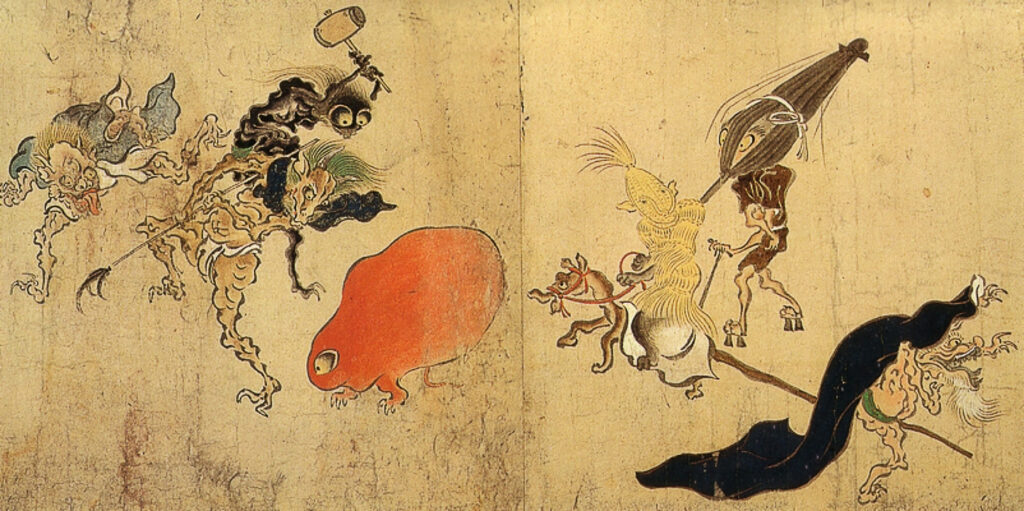
妖怪・精霊は元々は姿の見えない自然の中のエネルギー、不可思議な現象でしたが時代が下るにつれてヴィジュアルとして表現されるようになります。中世、鎌倉時代以降は絵巻物や御伽草子といった絵物語により具体的な姿を持った妖怪たちが続々と登場します。寺社縁起として製作される絵巻がある一方で、御伽草子をはじめ娯楽性の高い絵巻も登場し妖怪は次第に娯楽の対象にもなっていきました。有名なところでは『付喪神絵巻』や『百鬼夜行絵巻』に描かれた妖怪、付喪神(つくもがみ)の姿があります。付喪神は長い年月を経た道具などにカミや精霊などが宿ったもので、人をたぶらかすとされています。道具は100年という年月を経ると精霊を得てこれに変化(へんげ)することが出来ると考えられていました。「つくも」とは、「百年に一年たらぬ」と『付喪神絵巻』の詞書きにあることから「九十九」(つくも)のことであるとされ、「長い時間(九十九年)」を示しているとされています。この器物、物にも精霊=エネルギーが宿るという考え方は非常に良く日本の文化がアニミズムに根ざしているということを表しています。そして、目に見えないモノのキャラクター化、そしてそのヴァリエーションの豊富さが現代の日本のサブカルに通じています。
Originally, yokai and spirits were invisible energy in nature and mysterious phenomena, but as time went on, they came to be expressed visually. From the Kamakura period (1185-1333) onward, yokai began to appear one after another in concrete form in emakimono (picture scrolls) and otogi-zoshi (Japanese prose narratives written primarily in the Muromachi period (1392–1573)). While some emakimono were produced to tell the origin stories of temples and shrines, otogi-zoshi and other picture scrolls with high entertainment value also appeared, and yokai gradually became an object of entertainment. One of the most famous examples is the figure of a yokai, Tsukumogami, depicted in the “Picture Scroll of Tsukumogami” and “Picture Scroll of Hyakki Yagyo”. Tsukumogami is a term used to describe tools that have been used for a long time and are believed to be inhabited by kami and spirits, and to play tricks on people. It is believed that after 100 years, a tool can acquire a spirit and change into this. The word “Tsukumo” is said to be a reference to the word “99” (tsukumo) in the ” Picture Scroll of Tsukumogami”, which means “a long time (99 years)”. This belief that spirits, or energy, reside in vessels and objects is a very good example of how Japanese culture is rooted in animism. The characterization of invisible existence, and the abundance of variations on that characterization, is the element that makes Japanese subculture what it is today.

絵巻物や芸能(能・浄瑠璃)を通じた娯楽の場に描かれる妖怪たちの要素は主として公家・寺社などが主体となっていたものでしたが、室町・戦国時代を経て武家から町人ひろまってゆき、江戸時代初期と文化的地つづきになっています。江戸時代に(といっても300年あるので、ザックリくくると)入ると、印刷・出版技術の発展とともに、出版文化が発達していき、妖怪たちはさらに庶民の文化、サブカルチャに浸透していきました。かるた、すごろく、立版古など児童向けの玩具に類する出版物の図柄にも妖怪が使われ、本来は畏怖の対象だったであろう妖怪が人々にとって親しみのあるキャラクターとしても捉えられるようになっていったのです。浮世絵などの画題としても妖怪は描かれるようになります。ちなみに、浮世絵はクロード・モネなど印象派の画家たちに影響を与え、19世紀後半にヨーロッパを中心に「ジャポニスム」を広めたためハイ・アートのように思われていますが、しかし、元々は美人画、役者絵、名所絵など、当時の風俗を反映した、幕府からは「悪所」とされた場所こそ中心題材であり、まさに江戸時代のサブカルチャと言えるものです。
The elements of yokai depicted in entertainment through picture scrolls and performing arts (Noh and Joruri) were mainly those of court nobles, temples and shrines, but after the Muromachi and Sengoku periods, they spread from the samurai to the townspeople, and became culturally connected with the early Edo period. In the Edo period ( well, there are 300 years to summarize), with the development of printing and publishing technology yokai became even more prevalent in the culture and subculture of the common people. Yokai were also used in the designs of publications/toys for children, such as karuta, sugoroku, and *Tatebanko, and the yokai, which had originally been an object of awe, came to be seen as a familiar character to people. Yokai also came to be depicted as subjects in ukiyoe paintings. Ukiyoe is often thought of as high art because it influenced impressionist painters such as Claude Monet and spread “Japonisme” in Europe in the late 19th century, but it was originally used for paintings of beautiful women, actors, and famous places that reflected the customs of the time and were considered “bad places” by the shogunate. However, it was originally a subculture of the Edo period.
*Tatebanko : papercraft sculpture representing a scene akin to a painting.

僕が特に好きな浮世絵師は歌川国芳と月岡芳年です。歌川国芳(うたがわ くによし、寛政9年11月15日(1798年1月1日)- 文久元年3月5日(1861年4月14日))は江戸時代末期を代表する浮世絵師の一人であり、画想の豊かさ、斬新なデザイン力、奇想天外なアイデア、確実なデッサン力を持ち、浮世絵の枠にとどまらない広範な魅力を持つ作品を多数生み出しました。武者絵で有名な歌川国芳ですが、妖怪も多く描いています。有名な『相馬の古内裏(ふるだいり)』は平将門の遺児である滝夜叉姫(たきやしゃひめ)が呼び出した骸骨の妖怪が大宅太郎光国(おおやたろうみつくに)にまさに襲い掛かからんとする場面を描いています。原作(山東京伝による読本『善知鳥安方忠義伝』(うとうやすかたちゅうぎでん))では等身大のたくさんの骸骨が現われるところを、歌川国芳は1体の巨大な骸骨として描いている点に工夫と特色があります。妖怪的にいうと「がしゃどくろ(餓者髑髏)」でしょうか。がしゃどくろは昭和中期に創作された妖怪であり、水木しげるの「ゲゲゲの鬼太郎」などに登場し有名になりましたが、骸骨のバケモノというのは古今東西共通したモチーフです。
My favorite Ukiyoe artists are Kuniyoshi Utagawa and Yoshitoshi Tsukioka. Kuniyoshi Utagawa (November 15, 1798 – April 14, 1861) was one of the most famous Ukiyo-e artists of the late Edo period. With his rich imagination, innovative designs, unconventional ideas, and precise drawing skills, he created many works with a wide range of appeal not limited to the framework of Ukiyoe.
Utagawa Kuniyoshi is famous for his samurai paintings, but he also painted many yokai. The famous “Furudairi of Soma” ( Princess Takiyasha Calling up a Monstrous Skeleton Specter at the Old Palace in Soma) depicts a scene in which a skeletal demon summoned by Princess Takiyasha, the orphaned child of Taira no Masakado, is about to attack Mitsukuni Oyataro. The original story (the reading “Utouyasukata Chuugiden” by Santo Kyoden) had many life-sized skeletons, but Utagawa Kuniyoshi depicted the scene as a single giant skeleton. In terms of yokai, this is the “Gashadokuro” (hungry skull). Gashadokuro was created in the middle of the Showa period (1926-1989) and became famous when it appeared in “Gegege no Kitaro” by Shigeru Mizuki. The skeletal monster is a common motif in all times and places .
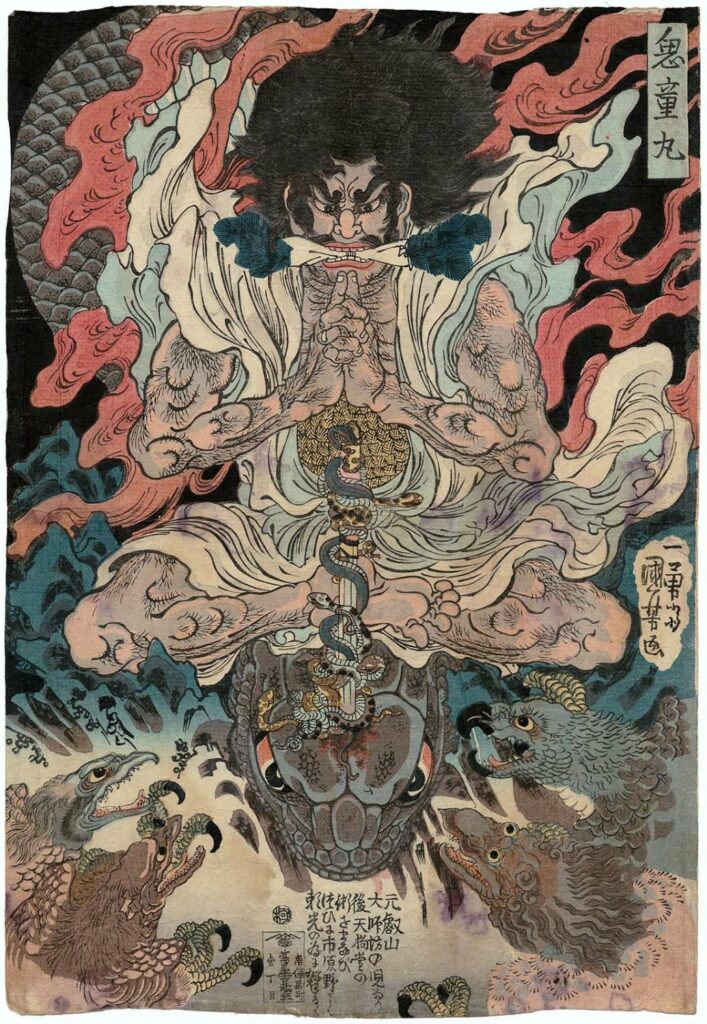
同じく国芳による『鬼童丸』は、有名な鬼である酒呑童子の子供とされる妖怪(鬼人、人と鬼のハイブリッド 週刊少年ジャンプ漫画の主人公になりそう)をモチーフとしたものです。スタイライズされた炎と共に、大蛇に乗った鬼童丸の姿が大迫力で迫ってきます。国芳の作品はデッサン力も素晴らしいですが、画面の構成、キャラクタの動きの切り取り方が非常にスタイライズされていて、現代のアニメに通じるところがあります。
Kido-maru” , also by Kuniyoshi, is based on a yokai (a hybrid of human and demon that would make a good protagonist for the Weekly Shonen Jump manga) that is believed to be a child of the famous demon, Sahutendoji. Along with stylized flames, the figure of Kidomaru riding a giant snake comes at you with great power. Kuniyoshi’s works have great sketching skills, but the composition of the screen and the way he cuts out the movements of the characters are very stylized, which is similar to modern animation.
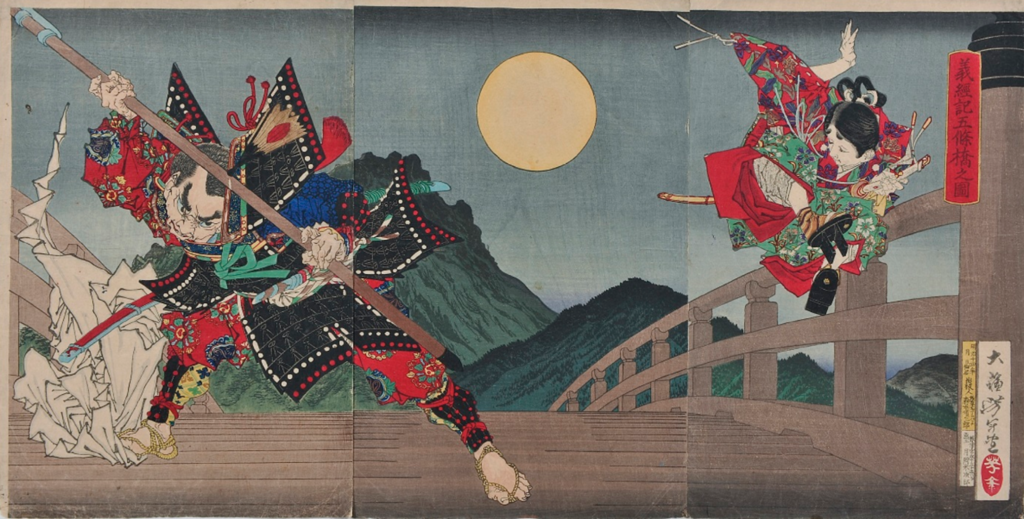
一方、月岡芳年(つきおか よしとし、1839年4月30日(天保10年3月17日) – 1892年(明治25年)6月9日)は、幕末から明治中期にかけて活動した浮世絵師で、歴史絵、美人画、役者絵、風俗画、古典画、合戦絵など多種多様な浮世絵を手がけ、各分野において独特の画風を見せる絵師です。動きの瞬間をストップモーションのように止めて見せる技法は、昭和期以降に発展してきた漫画や劇画にも通じるものがあり、劇画の先駆者との評もあります。(上記画像)歌川国芳と同じく月岡芳年も武者絵で有名ですが、妖怪や神話をモチーフとした作品も多く描いています。
On the other hand, Yoshitoshi Tsukioka (April 30, 1839 – June 9, 1892) was an ukiyo-e artist active from the end of the Edo period to the middle of the Meiji period. He produced a wide variety of ukiyo-e works, including historical paintings, paintings of beautiful women, paintings of actors, genre paintings, classical paintings, and battle paintings, and showed a unique style in each field. His technique of stopping and showing the moment of movement as if it were stop-motion has something in common with manga and graphic novels, which have been developed since the Showa period, and he is regarded as a pioneer of graphic novels.(Above image)Like Kuniyoshi Utagawa, Yoshitoshi Tsukioka is also famous for his samurai paintings, but he has also painted many works with motifs of monsters and myths.

『素戔嗚尊出雲の簸川上に八頭蛇を退治し給う図』では古事記の中のエピソード、スサノオノミコトによるヤマタノオロチ退治を独特かつ迫力あるタッチで描いています。ヤマタノオロチといえば日本神話に登場するなかで最大の妖怪、というより怪獣です。この絵の中では頭がひとつしかありませんが。独特な形状の水飛沫、スサノオノミコトの服の皺と相まって他に類を見ない浮世絵となっています。芳年は生涯をかけ、自らの作品の主題として妖怪を重要視していましたが、そうした中でも『新形三十六怪撰』(しんけいさんじゅうろっかいせん)は芳年の妖怪画の集大成と賞されています。
In “Susanoo-no-Mikoto Izumo no Hikawakami ni Yamatano orochi”, he depicts the conquest of Yamata-no-Orochi by Susanoo-no-Mikoto, an episode in the Book of Ancient Matters, with a unique and powerful touch.Yamata-no-orochi is the largest monster in Japanese mythology, or rather a monstrous beast. In this picture, it has only one head. The unique shape of the water splashes and the wrinkles on Susanoo-no-Mikoto’s clothes make this a unique ukiyoe. Yoshitoshi emphasized the importance of specters as the subject of his works throughout his life, and “Shinkei Sanjurokkaisen” is considered to be a compilation of his paintings of specters.
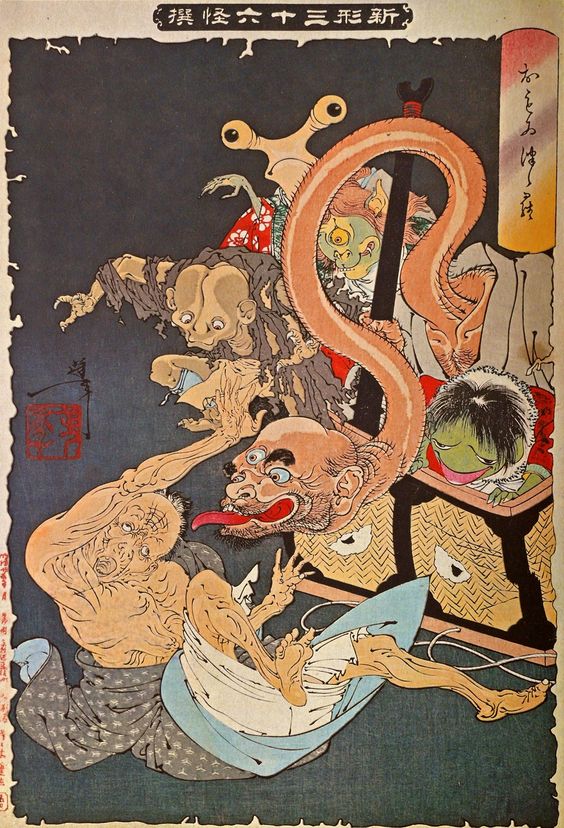



国芳、芳年とは少し趣が異なりますが妖怪を語る上で外せないのが鳥山石燕(とりやま せきえん、正徳2年(1712年) – 天明8年8月23日(1788年9月22日)です。石燕は日本画の巨大画派である狩野派の門人として絵を学なび、安永5年に『画図百鬼夜行(がずひゃっきやこう)』を刊行。この作品の発表から妖怪といえば鳥山石燕!といえるほど妖怪絵師として大成しました。石燕はその他にも『今昔画図続百鬼』『今昔百鬼拾遺』『百器徒然袋』という作品を刊行しており、これらの作品を総称して「画図百鬼夜行」と呼ばれることもあります。石燕の描く妖怪画は、後年葛飾北斎や歌川豊国・歌川豊広が合巻や読本などで描いている恐怖心や嗜虐性をいたずらにかきたてる種類のものではなく、『百鬼夜行絵巻』などの妖怪絵巻や赤本の「化物づくし」などに見られてきた、むしろ微笑みや奇妙さを誘う作風であるのが特徴です。
Although a little different from Kuniyoshi and Yoshitoshi, Toriyama Sekien (1712 – September 22, 1788) is the one who should not be overlooked when talking about yokai. Sekien studied painting as a student of the Kano style, a huge sect of Japanese painting, and published “Gazu Hyakki Yakou” (One Hundred Demon Nights) in 1776. Since the publication of this work, he has been known as a painter of yokai.He also published other works such as “Konjaku Gazu Zoku Hyakki”, “Konjaku Hyakki Shuui”, and “Hyakki Tsurezurebukuro”, which are sometimes collectively called “Gazu Hyakki Yakou”. Sekien’s paintings of yokai are characterized by a style that invites smiles and strangeness, which has been seen in yokai picture scrolls such as “Hyakki Yako ” and “Bakemono Zukushi” in red books, rather than the kind of paintings that unnecessarily stir up fear and a sense of cruelty that Katsushika Hokusai, Utagawa Toyokuni, and Utagawa Toyohiro depicted in their later works such as Go-kan and Yomi-hon.

河童・天狗・猫又・狸・狐といった幅広く知られる有名な伝承に見られる妖怪も多く描かれている他に、よりニッチな妖怪、鉄鼠(頼豪阿闍梨)や黒塚(安達ヶ原の鬼婆)などや、『古今百物語評判』(1686年)に見られる妖怪たち(垢嘗(あかなめ)・釣瓶火(つるべび)・鎌鼬(かまいたち))など先行作で描かれている妖怪なども多く描かれ、まさに妖怪百科事典です。石燕は伝承・伝説で伝わる妖怪だけではなく、当時の風俗や、情勢の風刺、だじゃれ等を用いて自ら妖怪を創作したとされています。妖怪 機尋(はたひろ)は、石燕の『今昔百鬼拾遺』で描かれている日本の妖怪の一つで、布の妖怪。機(はた)で織られた布がヘビの姿と化したものです。『今昔百鬼拾遺』の解説文によれば、ある女性が外出して帰らない夫への怨みを抱きながら機を織っていると、その怨みの念が織っている布にこもり、蛇の姿と化して夫の行方を探しに行くものが機尋であるということです。一説によれば、邪心(じゃしん)と蛇身(じゃしん)の語呂合わせで石燕が創作した妖怪とされています。
石燕の妖怪画は後世の画家たちにも多くの影響を与えており、石燕による作品がそのまま一般的な「妖怪」のヴィジュアルとして定着しているものも多いです。現代の日本人のもつ妖怪のイメージは水木しげる氏に拠るところが大きいですが、水木氏による妖怪画も石燕作品に取材したものが多く、それを考えると鳥山石燕の作品は水木しげる氏を通じて現代に受け継がれているとも言えます。こうして古き精霊たちは、妖怪となり、サブカルチャとなって流布し、現代まで時代を超えて生き残っているのです。
In addition to the many yokai depicted in the well-known folklore of kappa, tengu, nekomata, raccoon dogs, and foxes, there are also many more niche yokai such as Tesso (Raigo Ajari) and Kuro-zuka (Onibaba of Adachi-ga-hara), as well as yokai depicted in earlier works such as “Kokin Hyakumonogatari Reputation” (1686) (Akaname, Tsurubebi, and Kamaitachi). (Akaname, Tsurubebi, Kamaitachi), and many other monsters that have been depicted in earlier works, making it a veritable encyclopedia of monsters. It is said that Sekien created his own yokai not only from legends and folklore, but also from the manners and customs of the time, satire of the situation, and jokes.The yokai Hatahiro is one of the Japanese yokai depicted in Sekien’s “Konjaku Hyakki Shuui” (The Hundred Demons of the Past and Present) and is a fabric yokai. The cloth is woven on a loom, and is transformed into a snake. According to the commentary in “Konjaku Hyakki Shuui” (The Hundred Demons of the Past and Present), when a woman weaves a cloth while holding a grudge against her husband who never returns home, the grudge gets trapped in the cloth she is weaving, and the cloth turns into a serpent and goes looking for him. According to one theory, it is said that Sekien created this monster by combining the words “jashin” (邪心 evil heart) and “jashin” (蛇身 snake’s body).
Sekien’s paintings of yokai have had a great influence on later generations of artists, and many of his works have become common visual images of yokai. The modern Japanese people’s image of yokai is largely based on Shigeru Mizuki’s work, but many of Mizuki’s paintings of yokai are also based on Sekien’s works. It can be said that the works of Toriyama Sekien have been passed down to the present day through Mizuki Shigeru. In this way, old spirits have become yokai, subcultures that have spread and survived through the ages until the present day.
水木しげる氏の話をすると言っておきながら、また現代まで辿り着きませんでした。この続きはまた次回で。
Although I said I would talk about Shigeru Mizuki, I did not get to the present day again. I will continue this in the next article.
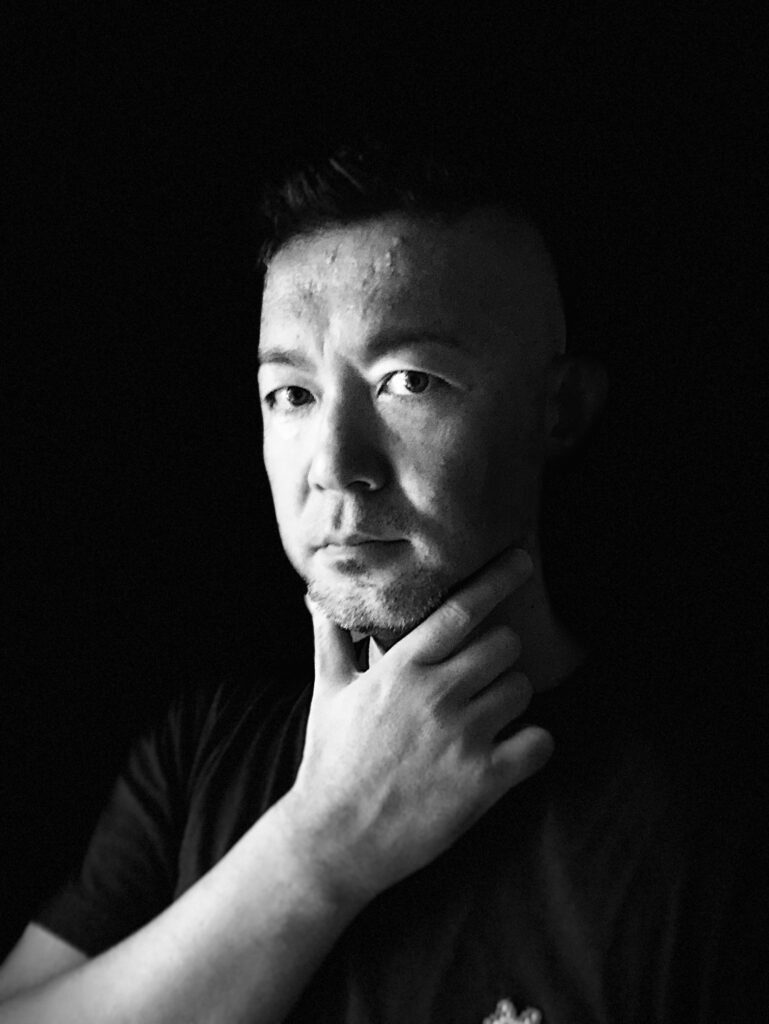
小林 武人 ポストデジタル・アーティスト
Taketo KOBAYASHI
Post-digital artist
ARTSTATION
Taketo Kobayashi (artstation.com)
Instagram ID
@humanoise
NPO法人JOMONISM 代表
https://humanoise.artstation.com
慶應義塾大学 環境情報学部卒。東京工科大学クリエイティブ・ラボ、株式会社ゴンゾを経てフリーランスに。現在は“ポストデジタル・アーティスト”として、CGや3Dプリント等のデジタルツールを“筆”として使いこなし、立体作品から映像まで幅広く制作。海外でも積極的に活動しており、美術家 坂巻善徳 a.k.a. senseとのコラボレーションプロジェクト“XSENSE”では、デジタル作品をストリートアートに活かし、ミューラル(壁画)を制作(コロラド州、デンバー)。また、独自の世界観のアニメーションを舞台美術として使い、コンテンポラリー能劇団とコラボレーションで公演も行った(サンフランシスコ、デンバー)。
自身の作品制作の他に、NPO法人JOMONISMが行う”ARTs of JOMON”展のキュレーションも担当。縄文文化から影響を受けた現代美術作家を世界に紹介し続けている(青森県立美術館、スパイラルガーデン、デンバー国際空港、クアラ・ルンプール等)。
目に見えないモノ、感情、エネルギー、意識の次の次元…等をカタチにすることがミッション。
現在はシンガポール在住
職歴・作品履歴(抜粋)
2004年
TVアニメーション「岩窟王」:背景デザイン、モデリング担当
2005年
スズキ「バーグマン」WEBプロモーション:バーグマン、モデリング担当
2007年
NHK アニ・クリ「火男(ヒョットコ)」:デザイン、モデリング担当
2012年
「MYSTICAL ABYSS」
アメリカ、サンフランシスコ、コンテポラリー能劇団Theatre of Yugenの公演、Mystical Abyss でオリジナルアニメーション制作、ライブプロジェクション担当
2013年-
アメリカ、デンバー、Art Across Cultures, Hope Onlineなどと共同で公演に参加。デンバーアート・ミュージアム等でアニメーションのプロジェクションを担当
2014年
2月 NPO法人JOMONISM企画「ARTs of JOMON展」@青森県立美術館、キュレーション担当
5月 シンガポール南洋工科大学3DPコンペティション参加。カンファレンス招待
11月 企業コラボーレションアート参加:オークリーストア原宿店にて作品展示
2015年
1月 NPO法人JOMONISM企画「ARTs of JOMON展」@スパイラルガーデン、キュレーション担当
2017年
“ARTs of JOMON -Hyper Subculture-” 展 キュレーション担当
伊勢丹 the ジャパンストア、クアラルンプール、マレーシア
2018年
”YouFab Exhibition – Imagination Manifests”@青年廣場 HongKong “More Than Human”プロジェクト、3Dプリント義足を展示
2019年
グループ展『童心』出展 銀座ホワイトストーン・ギャラリー
2020年
「Lights to the Night」アーティストに選出。シンガポール、アジア文明博物館にプロジェクション・マッピング
受賞歴等
オリジナルアニメーション『祭』(2010)
シーグラフ・アジア アニメーションシアター入選
YAOYOROZシリーズ『薬師如来』(2013)
3Dプリント用3DCG作品。日本図学会モデリングコンテスト、入賞
『SC1-EXP』(2014)
3Dプリント作品に映像をプロジェクション・マッピングしたインタラクティブ作品。
逗子国際プロジェクション・マッピング・フェスティバル、グランプリ
More Than Human『type-Unicorn』(2015)
3Dプリント義足。Ufab Global Creative award、ファイナリスト
“Eisen Herz”(2016)
構造計算を用いた3Dプリントミニ四駆カヴァー
Ufab Global Creative award、ファイナリスト
Taketo Kobayashi
Post-digital artist
ARTSTATION Taketo Kobayashi (artstation.com)
Instagram ID @humanoise
After having experience of 3D graphics and animation at Tokyo Institute of Technology creative laboratory, and Gonzo Co., Ltd., Taketo started his own project as an artist. Using digital technology like CG, 3D printing as his “brush”, Taketo creates a wide variety of artworks from 3D printed sculpture to animation. In a collaboration project XSENSE, Taketo utilizes CGI in street art to create murals(Denver, CO, USA), also using his unique style animation for stage design and collaborated with contemporary Noh theatrical group. In addition to creating his own artworks, Taketo curates the group art show “ARTs of JOMON” hosted by Japanese non-profit JOMONISM, keep introducing contemporary artists/artworks influenced by ancient Japanese Jomon culture.(Aomori Museum of Art / Spiral Garden / Denver International Airport / Kuala Lumpur)
It is Taketo’s mission to make invisible things, emotions, energy, next dimensions of consciousness into “shapes”.
Project/Art history(excerpt)
PROJECTS Digital G-O-D, UltraSuperNew gallery, Singapore, Jan 2020
Haw Par Villa RE•MIX
Chinese Cultural Centre, Singapore , Jan 2020
”Light to Night Festival” Projection mapping at Asian Civilization Museum, Singapore , Jan 2020
A SIGN OF THE TIMES EXHIBITION, Singapore , Jan 2019
”ARTs of JOMON” exhibit @ISETAN KL, Malaysia , Aug 2017, curation&direction
“Colorado Crush”, a mural festival in Denver, CO. Sept 2016, created artwork
“DMS” Collaboration with Canon June 2015, created&exhibited 3D printed prosthetic leg
”Oakley Exhibition” Exhibited artworks at Oakley store Harajuku, Tokyo, Oct 2014
AWARDS “Eisen Herz” Ufab Global Creative award Finalist. 2016. 3D printed cover for “Tamiya mini 4WD” using generative design
“More Than Human type-Unicorn” a 3D printed prosthetic leg. Ufab Global Creative award Finalist. 2015
“SC1-EXP” Zushi International Projection Mapping Competition, Grand Prix. 2014
“Yakushi-Nyorai”(2013)
3DCG model for 3D printing. Winning work at Digital modeling competition held by Japan Society for Graphic Science
Original CG animation ‘Matsuri’(May 2010)
Design, modeling, production coordination. A CG animation based on Japanese ‘Jomon’ culture. Created for promotion of Aomori Prefecture. Accepted at Siggraph Asia 2010. (On VIMEO: https://vimeo.com/25144961)
出典 References
『百鬼夜行絵巻』(部分)A part of “Picture Scroll of Hyakki Yagyo”.
https://ja.wikipedia.org/wiki/%E7%99%BE%E9%AC%BC%E5%A4%9C%E8%A1%8C%E7%B5%B5%E5%B7%BB#/media/%E3%83%95%E3%82%A1%E3%82%A4%E3%83%AB:Hyakki-Yagyo-Emaki_Tsukumogami_1.jpg
江戸時代の妖怪すごろく Sugoroku of Yokai in the Edo Period
https://www.kumon-ukiyoe.jp/index.php?main_page=product_info&cPath=3_14&products_id=858
『相馬の古内裏(ふるだいり)』
Princess Takiyasha Calling up a Monstrous Skeleton Specter at the Old Palace in Soma
https://mag.japaaan.com/archives/15739
『鬼童丸』 Kido-maru
https://ja.wikipedia.org/wiki/%E9%AC%BC%E7%AB%A5%E4%B8%B8#/media/%E3%83%95%E3%82%A1%E3%82%A4%E3%83%AB:Kuniyoshi_Kidomaru.jpg
月岡芳年 Yoshitoshi Tsukioka
https://www.neribun.or.jp/event/detail_m.cgi?id=201805131526201032
『素戔嗚尊出雲の簸川上に八頭蛇を退治し給う図』
“Susanoo-no-Mikoto Izumo no Hikawakami ni Yamatano orochi”
https://mag.japaaan.com/archives/82737/2
『新形三十六怪撰』 “Shinkei Sanjurokkaisen”
https://www.pinterest.jp/pin/454089574902907095/
「蒲生貞秀臣土岐元貞甲州猪鼻山魔王投倒図」
‘Gamo Sadahide’s servant, Toki Motosada, hurling a demon king to the ground at Mount Inoha’
https://twitter.com/curiousordinary/status/1300214447324016641/photo/1
ぬっぺふほふ Nuppefuhofu
https://ja.wikipedia.org/wiki/%E7%94%BB%E5%9B%B3%E7%99%BE%E9%AC%BC%E5%A4%9C%E8%A1%8C#/media/%E3%83%95%E3%82%A1%E3%82%A4%E3%83%AB:SekienNuppeppo.jpg